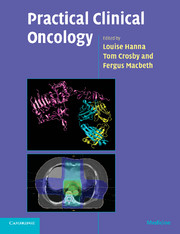Book contents
- Frontmatter
- Contents
- List of contributors
- Preface
- Acknowledgements
- Abbreviations
- 1 Practical issues in cytotoxic chemotherapy usage
- 2 Biological treatments in cancer
- 3 Hormones in cancer
- 4 Radiotherapy planning
- 5 Research in cancer
- 6 Oncological emergencies
- 7 Palliative care
- 8 Head and neck
- 9 Oesophagus
- 10 Stomach
- 11 Liver, gallbladder and biliary tract
- 12 Exocrine pancreas
- 13 Colon and rectum
- 14 Anus
- 15 Gastrointestinal stromal tumours
- 16 Breast
- 17 Kidney
- 18 Bladder
- 19 Prostate
- 20 Testis
- 21 Penis
- 22 Ovary
- 23 Body of the uterus
- 24 Cervix
- 25 Vagina
- 26 Vulva
- 27 Gestational trophoblast tumours
- 28 Lung
- 29 Mesothelioma
- 30 Soft tissue and bone tumours in adults
- 31 The lymphomas and myeloma
- 32 Central nervous system
- 33 Skin cancer other than melanoma
- 34 Melanoma
- 35 Thyroid
- 36 Neuroendocrine tumours
- 37 Cancer in children
- 38 Cancer of unknown primary
- 39 The use of radiotherapy in the treatment of benign conditions
- Multiple choice questions
- Multiple choice answers
- Index
- References
36 - Neuroendocrine tumours
Published online by Cambridge University Press: 23 December 2009
- Frontmatter
- Contents
- List of contributors
- Preface
- Acknowledgements
- Abbreviations
- 1 Practical issues in cytotoxic chemotherapy usage
- 2 Biological treatments in cancer
- 3 Hormones in cancer
- 4 Radiotherapy planning
- 5 Research in cancer
- 6 Oncological emergencies
- 7 Palliative care
- 8 Head and neck
- 9 Oesophagus
- 10 Stomach
- 11 Liver, gallbladder and biliary tract
- 12 Exocrine pancreas
- 13 Colon and rectum
- 14 Anus
- 15 Gastrointestinal stromal tumours
- 16 Breast
- 17 Kidney
- 18 Bladder
- 19 Prostate
- 20 Testis
- 21 Penis
- 22 Ovary
- 23 Body of the uterus
- 24 Cervix
- 25 Vagina
- 26 Vulva
- 27 Gestational trophoblast tumours
- 28 Lung
- 29 Mesothelioma
- 30 Soft tissue and bone tumours in adults
- 31 The lymphomas and myeloma
- 32 Central nervous system
- 33 Skin cancer other than melanoma
- 34 Melanoma
- 35 Thyroid
- 36 Neuroendocrine tumours
- 37 Cancer in children
- 38 Cancer of unknown primary
- 39 The use of radiotherapy in the treatment of benign conditions
- Multiple choice questions
- Multiple choice answers
- Index
- References
Summary
Introduction
Neuroendocrine tumours (NETs) constitute a heterogeneous group of neoplasms with significant variation in their mode of presentation and biological behaviour. They arise from neuroendocrine cells, which are widely distributed in the body; the spectrum of tumours that fall under this classification is accordingly diverse. Although tumours can arise within endocrine glands such as the pituitary and the parathyroids, tumours at these sites are typically benign, with limited growth potential, and are traditionally managed by endocrinologists. This chapter therefore focuses largely on NETs arising within the bronchial or gastroenteropancreatic systems, historically termed carcinoid tumours.
Management of these rare tumours is improving largely due to advances in imaging (especially nuclear imaging) and biochemistry (notably chromogranin A) and to the increased use of multidisciplinary teams in specialist centres (Kaltsas et al., 2004; Ramage et al., 2005). Treatment options are diverse and should be tailored individually but they may include one or more of surgery, medical therapy (somatostatin analogues, interferon alpha), chemotherapy, radionuclide therapy, and embolisation. Current clinical trials are focused on defining the optimal use of existing therapies and exploring novel agents such as angiogenesis and mTOR inhibitors.
Tumour types
NETs are classified according to (1) site of origin, (2) histological grade and (3) tumour stage.
The site of origin is traditionally divided along embryological lines into foregut tumours (bronchus, thymus, stomach, pancreas, proximal duodenum), midgut tumours (distal duodenum, jejunum, ileum, appendix, proximal and transverse colon) and hindgut tumours (distal colon, rectum).
- Type
- Chapter
- Information
- Practical Clinical Oncology , pp. 418 - 425Publisher: Cambridge University PressPrint publication year: 2008



